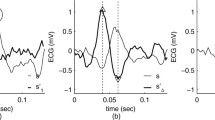Abstract
The main objective of this article is to implement and compare QRS subtraction techniques for intra-cardiac atrial electrograms based on using the surface ECG as a reference. A band-pass filter between 8 and 20 Hz followed by rectification, and then a low-pass filter at 6 Hz are used for QRS detection. QRS subtraction was performed using three different approaches: flat, linear and spline interpolations. QRS subtraction affects the power of the signals but it normally does not affect the dominant frequency. The average power of the atrial electrograms after QRS subtraction is significantly reduced for frequencies above 10 Hz.







Similar content being viewed by others
References
Ahmad A, Schlindwein FS, Ng GA (2010) Comparison of computation time for estimation of dominant frequency of atrial electrograms: fast fourier transform, Blackman Tukey, autoregressive and multiple signal classification. J Biomed Sci Eng (JBiSE) 3:843–847
Anuradha B, Kumar KS, Reddy VCV (2008) Classification of cardiac signals using time domain methods. APRN J Eng Appl Sci 3(3):7–12
Berenfeld O (2007) Quantifying activation frequency in atrial fibrillation to establish underlying mechanism and ablation guidance. Heart Rhythm 4:1225–1234
Berenfeld O, Mandapati R, Dixit S et al (2000) Spatially distributed dominant excitation frequencies reveal hidden organization in atrial fibrillation in the Langendorff-perfused sheep heart. J Cardiovasc Electrophysiol Il:869–879
Boardman A, Schlindwein FS, Thakor NV et al (2002) Detection of asphyxia using heart rate variability. Med Biol Eng Comput 40:618–624
Castells F, Mora C, RIeta JJ et al (2005) Estimation of atrial fibrillatory wave from single-lead atrial fibrillation electrocardiograms using principal component analysis concepts. Med Biol Eng Comput 43:557–560
Cooley J, Tukey O (1965) An algorithm for the machine calculation of complex Fourier series. Math Comput 19:297–301
Greville T (1969) Theory and applications of spline functions. Academic Press Inc, New York
Husser D, Stridh M, Sornmo L et al (2004) Frequency analysis of atrial fibrillation from the surface electrocardiogram. Indian Pacing Electrophysiol J 4(3):122–136
Kay SM, Marple SL (1981) Spectrum analysis—a modern perspective. Proc IEEE 69(11):1380–1419
Lin Y-J, Higa S, Kao T et al (2007) Validation of the frequency spectra obtained from the noncontact unipolar electrograms during atrial fibrillation. J Cardiovasc Electrophysiol 18:1147–1153
Mandapati R, Skanes A, Chen J et al (2000) Stable microreentrant sources as a mechanism of atrial fibrillation in the isolated sheep heart. Circulation 101:194–199
Mandapati R, Skanes A, Chen J et al (2000) Stable microreentrant sources as a mechanism of atrial fibrillation in the isolated sheep heart. Circulation 101:194–199
Nademanee K, McKenzie J, Kosar E et al (2004) A new approach for catheter ablation of atrial fibrillation: mapping of the electrophysiologic substrate. J Am Col Cardiol 43(11):2044–2053
Ng J, Goldberger JJ (2007) Understanding and interpreting dominant frequency analysis of AF electrograms. J Cardiovasc Electrophysiol 18:680–685
Okada M (1979) A digital filter for the QRS complex detection. IEEE Trans Biomed Eng BME 26(12):700–703
Pan J, Willis Tompkins J (1985) A real-time QRS detection algorithm. IEEE Trans Biomed Eng BME-32(3):230–236
Shah D, Yamane T, Choi K-J et al (2004) QRS subtraction and the ECG analysis of atrial ectopics. ANE 9(4):389–398
Skanes AC, Mandapati R, Berenfeld O et al (1998) Spatiotemporal periodicity during atrial fibrillation in the isolated sheep heart. Circulation 98:1236–1248
Slocum J, Byrom E, McCarthy L et al (1985) Computer detection of atrioventricular dissociation from surface electrocardiograms during wide QRS complex tachycardias. Circulation 72:1028–1036
Stridh M, Sörnmo L (2001) Spatiotemporal QRST cancellation techniques for analysis of atrial fibrillation. IEEE Trans Biomed Eng 48:1
Thakor NV, John Webster G, Tompkins WJ (1984) Estimation of QRS complex power spectra for design of a QRS filter. IEEE Trans Biomed Eng BME-31(11):702–706
Schumaker L (1993) Spline function: basic theory. Krieger Publishing Company, Malabar
Vaseghi SV (2008) Advanced digital signal processing and noise reduction, 3rd edn. Wiley, Chichester
Vaya C, Rieta J (2007) ECG signal quantization effects in the analysis of atrial fibrillation. In: Computers in cardiology. Durham, NC, pp 477–480
William JE, Thomson RE (2001) Data analysis methods in physical oceanography. Gulf Professional Publishing, Oxford
Acknowledgements
The study described in this article is part of the research portfolio supported by the Leicester NIHR Biomedical Research Unit in Cardiovascular Disease. This research is also funded by the Ministry of Higher Education of Malaysia and Universiti Teknologi Malaysia. In addition, João Loures is supported by The National Council for Scientific and Technological Development (CNPq) of Brazil, process no. 200598/2009-0.
Author information
Authors and Affiliations
Corresponding author
Rights and permissions
About this article
Cite this article
Ahmad, A., Salinet, J.L., Brown, P. et al. QRS subtraction for atrial electrograms: flat, linear and spline interpolations. Med Biol Eng Comput 49, 1321–1328 (2011). https://doi.org/10.1007/s11517-011-0829-9
Received:
Accepted:
Published:
Issue Date:
DOI: https://doi.org/10.1007/s11517-011-0829-9




